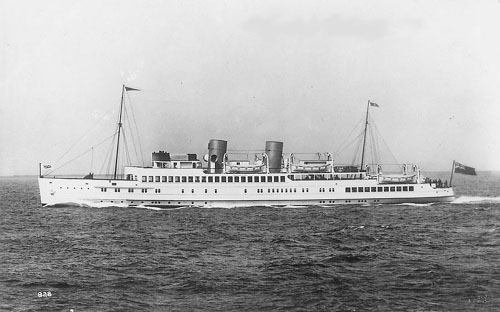
The ship was launched on May 3rd 1935 and was the first British diesel engined vessel for cross channel passenger/excursion use, being equipped with two 1,500hp Sulzer Type TS diesel engines. The use of diesels in the marine application had seen considerable successful development in the previous two decades but the initial cost of installation and running costs when compared to coal fired ships had hindered their use in the smaller vessels. However the larger dimensions of the Queen of the Channel when compared with the existing excursion/cross channel vessels allowed Denny's to install diesel engines.
Compared to the smaller paddle steamers that the Queen of the Channel was replacing, this ship was definately a step up with regard to the appointment of her fixtures and fittings.
On June 14th 1935 the ship was recorded as working its first run on a day excursion service between the Thames and the Continent. The profitably for this larger vessel would be its use on these cross channel 'no passport' workings from the Thames & North Kent ports following the easing of Government restrictions on this type of travel. This longer distance working would provide better useage of the ship rather than the expected sailings between London, Southend and Clacton. The ship would become a regular visitor to Ostend.
When the RMS Queen Mary commenced its maiden voyage from Southampton during May 1936 the Queen of the Channel worked a special excursion from the Medway to Southampton to celebrate the sailing.
On May 21st 1940 the Queen of the Channel was assisting troops at Boulogne.
The commencement of Operation Dynamo, the evacuation by sea of British & French troops trapped at Dunkirk during May 1940 led to a myriad of vessels being involved. Initially the harbour facilities at Dunkirk provided the obvious means to bring in the larger ships and embark the weary troops. Unfortunately the increasing German bombardement of the port from the ground and air made this a challenging and dangerous means of effecting the evacuation. The Queen of the Channel, under Captain O'Dell was one of the larger ships to use the harbour's eastern breakwater to embark troops early on the morning of May 28th. Approximately 950 troops were on the ship when she left Dunkirk at about 4.00am headed for Dover. Shortly into the journey the ship came under attack from German dive bombers. The bombs fell abaft of the main mast damaging the rudder, breaking the starboard propeller shaft and breaking the ship's back as it lifted out of the water.
With the Queen of the Channel in serious distress the nearby coaster Dorrien Rose under Captain W Thompson and carrying military stores approached bow to bow and within thirty five minutes had taken off the troops from the sinking ship. Also taken in tow were four of the Queen of the Channel's lifeboats, though two would later come adrift. The Dorrien Rose would reach Dover at about 2pm with its valuable cargo.
The damage sustained by the Queen of the Channel proved fatal and the ship sank on May 28th 1940. The loss of this ship saw daylight operations restricted to naval vessels and the smaller vessels. The larger unarmed vessels were now restricted to operating at night. Despite the loss of the Queen of the Channel, on May 28th 1940 a total of 17,804 persons were evacuated from Dunkirk, two thirds through the harbour area, the remainder from the beaches.
At high tide the wreck is at a depth of approximately twenty three metres.
General Details
Builder: William Denny & Brothers, Dumbarton.
Launched: 1935
Length: 255ft
Beam: 34ft
Draught 9ft 3in
Weight: 1,162 tons gross
Engines: Two Sulzer 8 cyl two-stroke single acting 1,500hp engines, Type TS.
Screws: 2
Service Speed: 20 knots
Port of Registry: London
Crew: ??
Passengers: ??
Sources
Rickard, J (16 February 2008), Operation Dynamo, the evacuation from Dunkirk, 27 May-4 June 1940, http://www.historyofwar.org/articles/operation_dynamo.html
Page added February 22nd 2009.
Last Updated May 20th 2011.
Return to Ship menu
Return to site menu